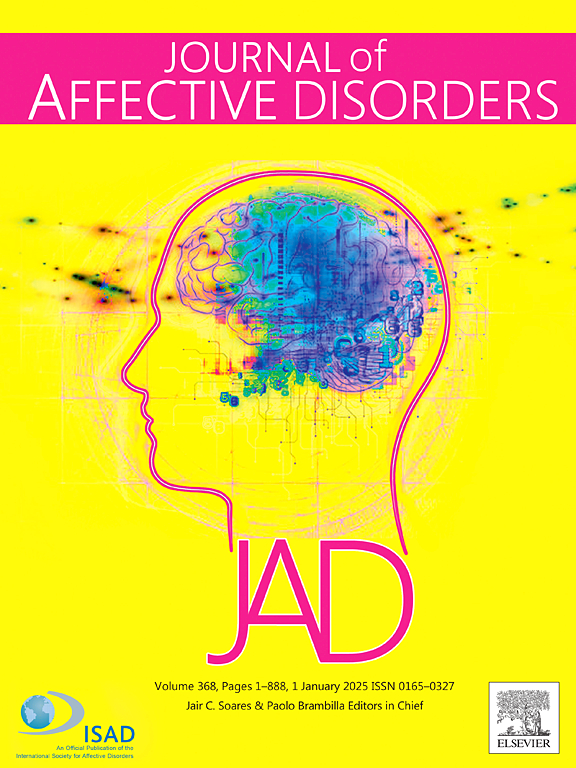Relationships between childhood maltreatment, peer victimization and depressive symptoms in youth: a network approach on the cycle of victimization
IF 4.9
2区 医学
Q1 CLINICAL NEUROLOGY
引用次数: 0
Abstract
Background
Adverse childhood experiences (ACEs), such as childhood maltreatment and peer-related problems, are among the most influential risk factors contributing to the development of depressive symptoms in children and adolescents. Using a network approach, this study investigated the relationships between diverse forms of ACEs and distinct depressive symptoms in children and adolescents with psychiatric disorders.
Methods
A total of 464 psychiatric outpatients diagnosed with a range of psychiatric disorders (278 females; mean age = 14.2 years, standard deviation = 2.1 years) were included. The Children's Depression Rating Scale, Revised, was used to assess depressive symptoms. The shortened form of the Early Trauma Inventory and the Peer-Victimization Scale and Bullying Behavior Scale were used to assess childhood maltreatment experiences and peer-related problems, respectively.
Results
The relationship between various types of ACEs and depressive symptoms varied. In particular, emotional maltreatment was closely related to depressive symptoms and had a direct impact, as well as an indirect influence through peer victimization. In addition, “depressed feelings” was identified as the common key node within the ACEs-depressive symptoms networks.
Limitations
Due to the cross-sectional design of the study, caution is required when interpreting causal relationships.
Conclusions
Our findings provide new insights into the possible mechanisms between diverse forms of ACEs and individual depressive symptoms in children and adolescents with psychiatric disorders and highlight the importance of considering different intervention targets for each type of ACE.
童年虐待、同伴受害与青少年抑郁症状之间的关系:受害周期的网络方法
背景:童年不良经历(ace),如童年虐待和同伴相关问题,是导致儿童和青少年抑郁症状发展的最具影响力的风险因素之一。采用网络方法,本研究调查了不同形式的ace与患有精神障碍的儿童和青少年的明显抑郁症状之间的关系。方法:共464名诊断为一系列精神障碍的精神科门诊患者(278名女性;平均年龄 = 14.2 岁,标准差 = 2.1 岁)。儿童抑郁评定量表(修订版)用于评估抑郁症状。采用简化版早期创伤量表、同伴受害量表和欺凌行为量表分别评估儿童虐待经历和同伴相关问题。结果:不同类型ace与抑郁症状的关系存在差异。特别是,情绪虐待与抑郁症状密切相关,具有直接影响,也通过同伴受害产生间接影响。此外,“抑郁感觉”被确定为ace -抑郁症状网络中的共同关键节点。局限性:由于研究的横断面设计,在解释因果关系时需要谨慎。结论:我们的研究结果为不同形式的ACE与患有精神障碍的儿童和青少年个体抑郁症状之间的可能机制提供了新的见解,并强调了针对每种类型的ACE考虑不同干预目标的重要性。
本文章由计算机程序翻译,如有差异,请以英文原文为准。
求助全文
约1分钟内获得全文
求助全文
来源期刊

Journal of affective disorders
医学-精神病学
CiteScore
10.90
自引率
6.10%
发文量
1319
审稿时长
9.3 weeks
期刊介绍:
The Journal of Affective Disorders publishes papers concerned with affective disorders in the widest sense: depression, mania, mood spectrum, emotions and personality, anxiety and stress. It is interdisciplinary and aims to bring together different approaches for a diverse readership. Top quality papers will be accepted dealing with any aspect of affective disorders, including neuroimaging, cognitive neurosciences, genetics, molecular biology, experimental and clinical neurosciences, pharmacology, neuroimmunoendocrinology, intervention and treatment trials.
 求助内容:
求助内容: 应助结果提醒方式:
应助结果提醒方式:


